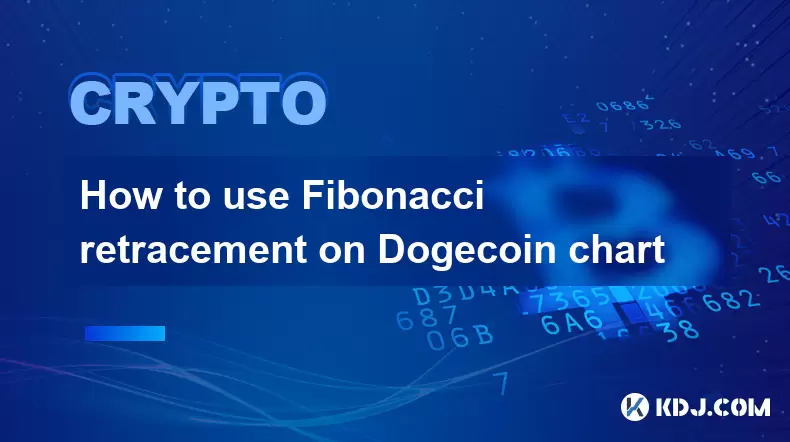-
 bitcoin
bitcoin $115849.501581 USD
-0.20% -
 ethereum
ethereum $4657.446044 USD
-1.30% -
 xrp
xrp $3.094289 USD
-0.74% -
 tether
tether $1.000313 USD
-0.03% -
 solana
solana $243.548889 USD
0.20% -
 bnb
bnb $930.722647 USD
0.20% -
 usd-coin
usd-coin $0.999696 USD
-0.01% -
 dogecoin
dogecoin $0.283551 USD
1.29% -
 tron
tron $0.349632 USD
-0.77% -
 cardano
cardano $0.915982 USD
-1.94% -
 hyperliquid
hyperliquid $54.899464 USD
-0.88% -
 chainlink
chainlink $24.718086 USD
-1.68% -
 ethena-usde
ethena-usde $1.001078 USD
-0.02% -
 sui
sui $3.756062 USD
0.14% -
 stellar
stellar $0.399024 USD
-1.87%
How to use Fibonacci retracement on Bitcoincoin chart
Fibonacci retracement helps Dogecoin traders identify key support and resistance levels, enhancing decision-making when combined with volume and candlestick patterns.
Jul 06, 2025 at 04:07 am

Understanding Fibonacci Retracement in Cryptocurrency Trading
Fibonacci retracement is a popular technical analysis tool used by traders to identify potential support and resistance levels. In the context of Dogecoin (DOGE) trading, this method can help anticipate where price might reverse or stall during a trend. The core idea behind Fibonacci retracement is based on key mathematical ratios derived from the Fibonacci sequence — 23.6%, 38.2%, 50%, 61.8%, and 78.6%. These percentages are used to draw horizontal lines that indicate possible reversal zones.
It's important to note that Fibonacci retracement does not guarantee price reversals, but it provides a framework for identifying areas of interest. When applied correctly, it can enhance decision-making when combined with other tools like volume indicators or candlestick patterns.
Setting Up Your Chart for Fibonacci Analysis
Before applying Fibonacci retracement to a Dogecoin chart, ensure your charting platform supports this feature. Most platforms like TradingView, Binance, or MetaTrader have built-in Fibonacci tools. Choose a timeframe that aligns with your trading strategy — intraday traders may use 1-hour or 4-hour charts, while swing traders often rely on daily or weekly charts.
To begin, locate a clear uptrend or downtrend in the Dogecoin price movement. In an uptrend, click on the lowest point of the trend and drag the cursor to the highest peak. Conversely, in a downtrend, start from the highest point and drag down to the lowest point. This action will automatically generate the Fibonacci levels across your chart.
Interpreting Key Fibonacci Levels in Dogecoin Price Action
Once the Fibonacci levels are plotted, each line represents a potential area where Dogecoin could experience a pullback or reversal. The 38.2% and 61.8% levels are considered the most significant due to their frequent role as strong support or resistance zones. Traders often observe how the price interacts with these levels to make informed entry or exit decisions.
For instance, if Dogecoin pulls back to the 61.8% retracement level and shows signs of rejection like a bullish engulfing pattern or increased buying volume, it could signal a continuation of the original uptrend. On the flip side, a breakdown below the 78.6% level may suggest a deeper correction or even a trend reversal.
Combining Fibonacci Retracements with Other Technical Tools
Using Fibonacci retracement alone may not provide enough confirmation for reliable trades. Integrating additional tools such as moving averages, RSI (Relative Strength Index), or MACD (Moving Average Convergence Divergence) can increase accuracy. For example, if Dogecoin reaches the 38.2% retracement level and the RSI dips into oversold territory (below 30), it strengthens the case for a potential bounce.
- Support and Resistance Confirmation: Check if Fibonacci levels align with previous support or resistance areas.
- Volume Analysis: Look for spikes in volume near Fibonacci levels to validate potential reversals.
- Candlestick Patterns: Observe bullish or bearish candlesticks forming around key Fibonacci zones for added confirmation.
This multi-layered approach ensures that you're not relying solely on one indicator, which helps reduce false signals and improves trade setups.
Practical Steps to Apply Fibonacci Retracement on Dogecoin Charts
Here’s a step-by-step guide to effectively apply Fibonacci retracement to Dogecoin:
- Open your preferred charting platform and load the Dogecoin chart.
- Select the Fibonacci retracement tool from the toolbar.
- Identify a recent significant price swing — either an uptrend or downtrend.
- Click on the swing low and drag the cursor to the swing high (for uptrends). For downtrends, do the opposite.
- Observe how current price action reacts to the plotted levels.
- Combine the retracement levels with other indicators for stronger trade signals.
Make sure to zoom out and look at multiple timeframes to understand broader trends. Also, avoid placing trades solely based on Fibonacci levels without confirming through other means like volume or momentum indicators.
Adjusting Fibonacci Levels Based on Market Conditions
Market conditions for cryptocurrencies like Dogecoin can change rapidly due to news events, social media hype, or macroeconomic factors. Therefore, it's crucial to reassess and adjust your Fibonacci levels regularly. If a new trend emerges, redraw your Fibonacci lines accordingly to reflect the updated price structure.
In volatile markets, price may overshoot expected retracement levels before reversing. Be prepared for scenarios where Dogecoin might temporarily break below the 78.6% level before bouncing back. Always keep stop-loss orders in place to manage risk effectively.
Frequently Asked Questions
Q: Can Fibonacci retracement be used on any cryptocurrency besides Dogecoin?Yes, Fibonacci retracement is applicable to all financial assets, including other cryptocurrencies like Bitcoin, Ethereum, and Litecoin. The principles remain the same regardless of the asset being analyzed.
Q: What should I do if Dogecoin breaks through all Fibonacci levels?If Dogecoin moves beyond the 78.6% retracement level without showing signs of reversal, consider it a potential trend reversal. Reassess your positions and look for new trend signals before making further trades.
Q: Is there a best timeframe to apply Fibonacci retracement on Dogecoin?There is no single best timeframe. Short-term traders may prefer 1-hour or 4-hour charts, while long-term traders often analyze daily or weekly charts. It depends on your trading style and goals.
Q: Do professional traders use Fibonacci retracement for crypto trading?Many professional traders incorporate Fibonacci retracement into their strategies, especially when combined with other technical tools. It’s widely respected for its historical accuracy in predicting price behavior across various markets.
Disclaimer:info@kdj.com
The information provided is not trading advice. kdj.com does not assume any responsibility for any investments made based on the information provided in this article. Cryptocurrencies are highly volatile and it is highly recommended that you invest with caution after thorough research!
If you believe that the content used on this website infringes your copyright, please contact us immediately (info@kdj.com) and we will delete it promptly.
- Crypto Presales 2025: Unlocking Millionaire Potential
- 2025-09-14 22:25:12
- Pi Network Price Prediction: Is $0 in 2026 a Real Possibility?
- 2025-09-14 22:50:12
- Remittix, Polkadot, VeChain: Navigating the Crypto Landscape in 2025
- 2025-09-14 22:50:12
- Shiba Inu, Ozak AI, and Presale Gains: Decoding the Crypto Buzz
- 2025-09-14 22:25:12
- MAGACOIN FINANCE: Altcoin Presale Heats Up, Analysts Rank It Among Top Crypto Gems
- 2025-09-14 22:30:12
- Shiba Inu Under Fire: Shibarium Exploit and SHIB Price Rollercoaster
- 2025-09-14 22:30:12
Related knowledge

Bitcoincoin burning mechanism
Jul 20,2025 at 09:21pm
What is the Dogecoin burning mechanism?The Dogecoin burning mechanism refers to the process of permanently removing DOGE tokens from circulation by se...

How to earn free Bitcoincoin?
Jul 19,2025 at 10:08pm
What is Dogecoin and Why Earn It?Dogecoin (DOGE) started as a meme-based cryptocurrency in 2013 but has grown into a widely recognized digital asset. ...

Is Coinbase a good wallet for Bitcoincoin?
Jul 19,2025 at 04:42pm
Understanding Coinbase as a Wallet Option for DogecoinWhen considering where to store Dogecoin, Coinbase is often mentioned as a potential option due ...

How to buy Bitcoincoin with PayPal?
Jul 23,2025 at 06:57am
Understanding the Basics of Buying DogecoinBefore diving into the process of buying Dogecoin with PayPal, it’s essential to understand what Dogecoin i...

Best app to buy Dogecoin
Jul 23,2025 at 03:08pm
What Is a Cryptocurrency Exchange and How Does It Work?A cryptocurrency exchange is a digital marketplace where users can buy, sell, or trade cryptocu...

How are Dogecoin gains taxed?
Jul 25,2025 at 07:01am
Understanding the Taxation of Dogecoin GainsWhen it comes to Dogecoin (DOGE), many investors are drawn to its meme-inspired branding and volatile pric...

Bitcoincoin burning mechanism
Jul 20,2025 at 09:21pm
What is the Dogecoin burning mechanism?The Dogecoin burning mechanism refers to the process of permanently removing DOGE tokens from circulation by se...

How to earn free Bitcoincoin?
Jul 19,2025 at 10:08pm
What is Dogecoin and Why Earn It?Dogecoin (DOGE) started as a meme-based cryptocurrency in 2013 but has grown into a widely recognized digital asset. ...

Is Coinbase a good wallet for Bitcoincoin?
Jul 19,2025 at 04:42pm
Understanding Coinbase as a Wallet Option for DogecoinWhen considering where to store Dogecoin, Coinbase is often mentioned as a potential option due ...

How to buy Bitcoincoin with PayPal?
Jul 23,2025 at 06:57am
Understanding the Basics of Buying DogecoinBefore diving into the process of buying Dogecoin with PayPal, it’s essential to understand what Dogecoin i...

Best app to buy Dogecoin
Jul 23,2025 at 03:08pm
What Is a Cryptocurrency Exchange and How Does It Work?A cryptocurrency exchange is a digital marketplace where users can buy, sell, or trade cryptocu...

How are Dogecoin gains taxed?
Jul 25,2025 at 07:01am
Understanding the Taxation of Dogecoin GainsWhen it comes to Dogecoin (DOGE), many investors are drawn to its meme-inspired branding and volatile pric...
See all articles










































































